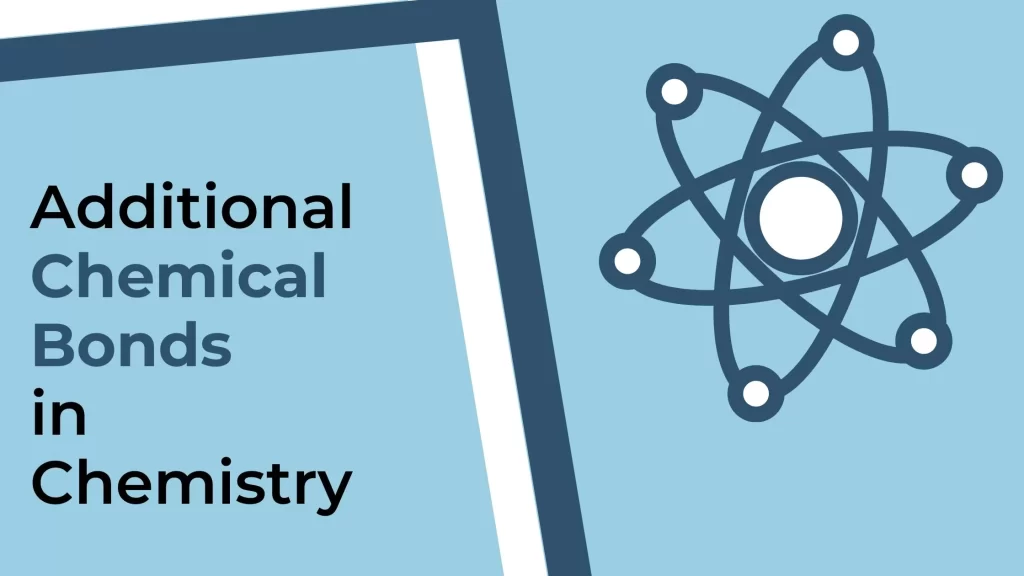Introduction
Hey there, I hope you’re doing good. Last time, we discussed the types of chemical reactions. In this blog, you’ll read about the meaning of chemical bonds. Adding to it, you’ll also get to know about the types of chemical bonds in Chemistry. Keep reading till the end of the blog to understand the bond ‘with examples’.
Let’s get started….
Meaning of Chemical bonds in Chemistry
Atoms tend to arrange themselves in the most stable patterns possible, which means that they have a tendency to complete or fill their outermost electron orbits. They join with other atoms to do just that. The force that holds atoms together in collections known as molecules is referred to as a chemical bond.
Types of Chemical Bonds in Chemistry
When substances participate in chemical bonding and yield compounds, the stability of the resulting compound can be gauged by the type of chemical bonds it contains.
The type of chemical bonds formed vary in strength and properties. There are 4 primary types of chemical bonds which are formed by atoms or molecules to yield compounds. These types of chemical bonds include:
- Ionic Bonds
- Covalent Bonds
- Hydrogen Bonds
- Polar Bonds
These types of bonds in chemical bonding are formed from the loss, gain, or sharing of electrons between two atoms/molecules.
Ionic Bonding
An ionic bond is formed when valence electrons are transferred from one atom to the other to complete the outer electron shell.
Ionic bonding involves a transfer of an electron, so one atom gains an electron while one atom loses an electron. One of the resulting ions carries a negative charge (anion), and the other ion carries a positive charge (cation). Because opposite charges attract, the atoms bond together to form a molecule.
It is usually observed when a metal bonds to a non-metal. The ionic bond gains strength from the difference in charge between the two atoms, i.e. the greater the charge disparity between the cation and the anion, the stronger the ionic bond.
Examples
- Sodium(Na) and chlorine (Cl) combine to form stable crystals of sodium chloride (NaCl), also known as common salt.
- Magnesium(Mg) and oxygen (O) combine to form magnesium oxide (MgO).
- Potassium(K) and chlorine (Cl) combine to form potassium chloride (KCl)
- Calcium(Ca) and fluorine (F) combine to form calcium fluoride (CaF2)
Covalent Bonding
A covalent bond is formed when the valence electrons from one atom are shared between two or more particular atoms.
Generally, a covalent bond indicates the sharing of electrons between atoms. Compounds that contain carbon (also called organic compounds) commonly exhibit this type of chemical bonding. The pair of electrons which are shared by the two atoms now extend around the nuclei of atoms, leading to the creation of a molecule. It is usually observed when a nonmetal bonds to a nonmetal
Examples
- Two atoms of iodine(I) combine to form iodine (I2) gas.
- One atom of carbon(C) combines with two atoms of oxygen (O) to form a double covalent bond in carbon dioxide (CO2).
- Two atoms of hydrogen(H) combine with one atom of oxygen (O) to form a polar molecule of water (H2O).
- Boron(B) and three hydrogens (H) combine to form the polar borane (BH3)
Polar Covalent Bonding
Covalent bonds can be either Polar or Non-Polar in nature. In Polar Covalent chemical bonding, electrons are shared unequally since the more electronegative atom pulls the electron pair closer to itself and away from the less electronegative atom. Water is an example of such a polar molecule.
A difference in charge arises in different areas of the atom due to the uneven spacing of the electrons between the atoms. One end of the molecule tends to be partially positively charged and the other end tends to be partially negatively charged.
Hydrogen Bonding
Compared to ionic and covalent bonding, Hydrogen bonding is a weaker form of chemical bonding. Certainly, it is a type of polar covalent bonding between oxygen and hydrogen wherein the hydrogen develops a partial positive charge. This implies that the electrons are pulled closer to the more electronegative oxygen atom
As a result, this creates a tendency for the hydrogen to be attracted toward the negative charges of any neighboring atom. This type of chemical bonding is called a hydrogen bond and is responsible for many of the properties
Examples
- Hydrogen atom from one molecule of water bonds with the oxygen atom from another molecule. This bonding is quite significant in ice.
- In chloroform (CH3Cl) and ammonia (NH3), hydrogen bonding occurs between the hydrogen of one molecule and the carbon/nitrogen of another.
- Nitrogen bases present in DNA are held together by a hydrogen bond.

Additional Chemical Bonds in Chemistry
Metallic Bonds
A metallic bond is formed when the valence electrons are not associated with a particular atom or ion but exist as a “cloud” of electrons around the ion centers.
Metallic materials have good electrical and thermal conductivity when compared to materials with covalent or ionic bonding. A metal such as iron has metallic bonding.
Moreover, a metallic bond is a force that holds atoms together in a metallic substance. Such solid consists of tightly packed atoms, where the outermost electron shell of each metal atom overlaps with a large number of neighboring atoms. As a consequence, the valence electrons move freely from one atom to another. They are not associated with any specific pair of atoms. This behavior is called non-localization.
Examples
- Sodium metal
- Aluminum foil
- Copper wire
Van der Waals Bond
Basically, the weak electric forces known as Van der Waals forces, hold together Neutral molecules. Van der Waals force is a general term that defines the attraction of intermolecular forces between molecules. This type of chemical bond is the weakest of all bonds.
Examples include hydrogen bonds, London dispersion forces, and dipole-dipole forces.
Peptide Bond
Within a protein, multiple amino acids are linked together by peptide bonds, thereby forming a long chain. Likewise, A biochemical reaction that extracts a water molecule forms Peptide bonds as it joins the amino group of one amino acid to the carboxyl group of neighboring amino acids.
Aside from peptide bonds, hydrogen bonds, ionic bonds, and disulfide bonds are also common in proteins.
Examples include polypeptides like insulin and growth hormone.
Thank you
for reading our blog. Kindly, share it with ‘Chemistry lovers.
Blog by: Dr. Mukta Jain
Department of Science
Biyani Group of Colleges, Jaipur
CLICK HERE
to pursue your graduation by sitting at your home.



